Rules for feeding tomatoes in a greenhouse: what fertilizers and when to use to get a rich harvest
Tomatoes are one of the finest vegetable crops. This fact is of particular relevance when plants are cultivated indoors, that is, in a greenhouse. Greenhouse tomatoes are vitally needed a complete top dressing - a complex of organic and mineral fertilizers.
Since the growth of tomatoes in a greenhouse is a real chance to bring the harvest closer by a couple of months, consider what is especially important when feeding tomatoes in a greenhouse, what fertilizers and when to use.
The content of the article
How to feed tomatoes in a greenhouse
Most elements important for feeding tomatoes: nitrogen, potassium, phosphorus.
Most often, gardeners who grow tomatoes for themselves use organic feeding. Industrial farms use a simpler and cheaper way to feed tomatoes in the summer - mineral fertilizers (magnesium sulfate, "Kemira universal").
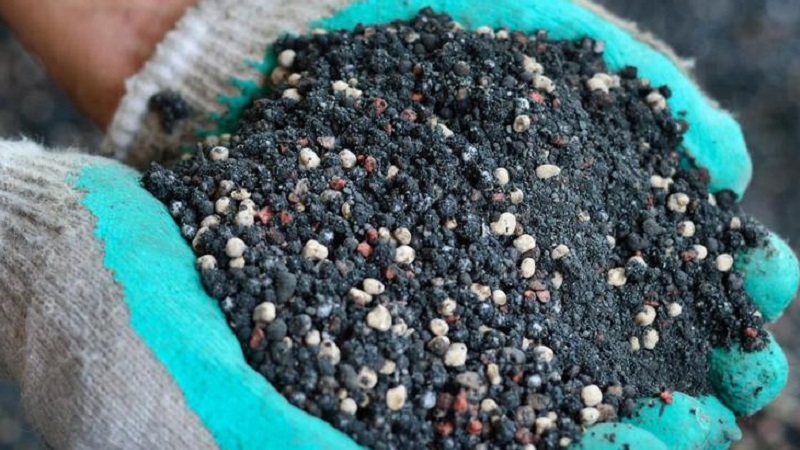
But the best option for fertilizing vegetable crops - use organic and mineral types of dressings. In this case, the plants receive all the important trace elements that they need for full growth and development.
Output. It is better to alternate organics and minerals.
Fertilization chart
The first feeding is carried out even before planting the seedlings in the greenhouse... For 1 m², use a bucket of compost or humus and two glasses of wood ash. Thanks to these organic substances, the earth is filled with nitrogen, potassium, phosphorus and other trace elements.
Fertilizers at different stages of vegetable growth
A vegetable crop needs a variety of fertilizers at every stage of its development.
Planting seedlings and ripening the bush
During the planting period, it is not required to add large amounts of fertilizer to the ground, since the soil with fertilizers (compost, humus, ash) already contains all the trace elements necessary for future seedlings. Within a week, the vegetable crop will adapt to the soil, after which the first leaves will appear.
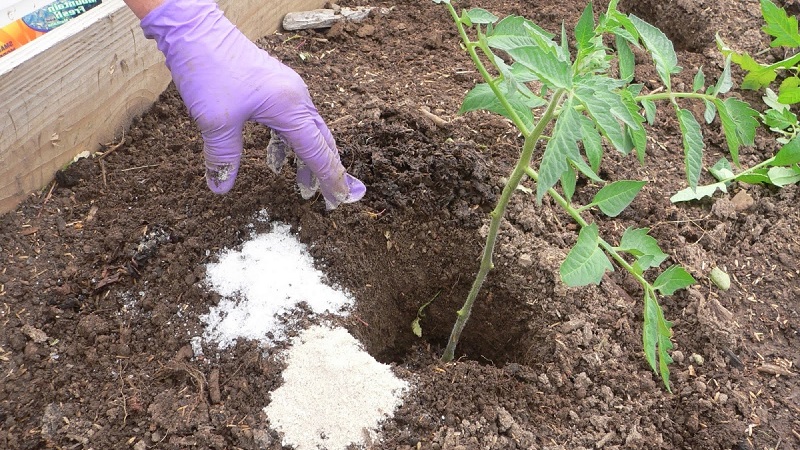
After 2 weeks, you can carry out mineral dressing substances that contain phosphorus (40 g), potassium (15 g) and nitrogen (25 g). Substances are diluted in 10 liters of water, 1 liter is used for each bush.
Important! During this period, fertilizers, including organic matter, must not be abused. If you overdo it with feeding (manure), the stems will become thick, the leaves will be large, but the fruits will be small and few in number.
Plant flowering and ovary formation
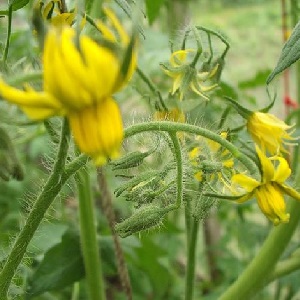 After planting seedlings in the greenhouse, do not rush to feed the plant... Wait a week and see how well the bushes take root. When the plant begins to bloom en masse, it's time to fertilize.
After planting seedlings in the greenhouse, do not rush to feed the plant... Wait a week and see how well the bushes take root. When the plant begins to bloom en masse, it's time to fertilize.
During flowering, fertilizing from organic matter (manure) and potassium sulfate is suitable. You can use the mineral fertilizing "Kemira-wagon".
When a plant begins to bear fruit and ripens, it especially needs potassium. Potassium accelerates the redistribution of nutrients and their entry into the resulting fruit.
Reference! During this period, the plant also especially needs nitrogen and phosphorus.
Fruit growth
Pay attention to how the plant develops as the fruit ripens.... If the stem has stopped growing and the leaves have faded, it is necessary to repeat the feeding. Dissolve 1 tbsp in a bucket of water.l. sodium humate and 2 tbsp. l. superphosphate. This solution will help the tomatoes grow faster.
If the plant is growing well, no feeding is required.
It can be useful:
What to do to make tomatoes in the greenhouse turn red faster
Types of dressings
Plant feeding are divided into two types: foliar and root.
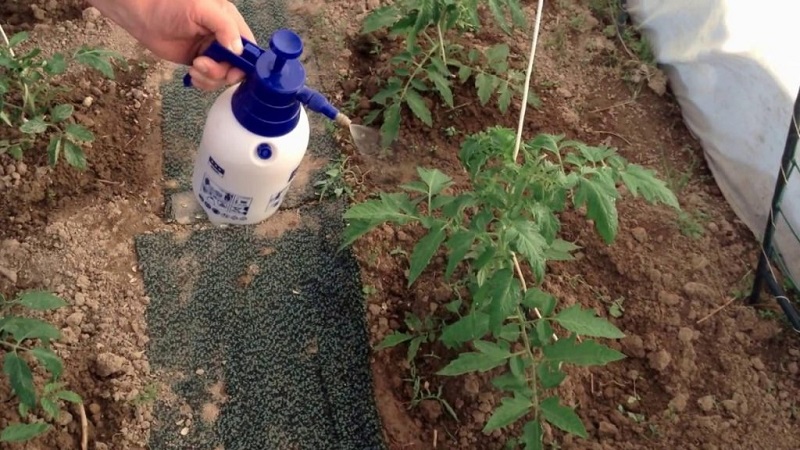
Foliar dressing
Foliar dressing necessary if you want to increase the yield of the plant... Do not overuse this type of feeding, carry it out only when necessary.
Top dressing is carried out in warm weather with open vents.
If the tomatoes are deficient in boron (the bushes bloom, but the fruits are not tied), the plants are sprayed with boric solution (2 g of boric acid is diluted in 10 liters of water). Iodine will protect the plant from late blight. 10 drops of iodine are diluted in 10 liters of water.
Root dressing
Root dressing carried out at all stages of plant maturation and fetal formation. It can be organic (compost, manure) or mineral (potassium sulfate, sodium humate, superphosphate).
Traditional methods
Organic fertilizers for feeding tomatoes are especially popular with gardeners:
- Ash... It is used to strengthen the root system, contains nitrogen, potassium and phosphorus. To prepare the solution, take 10 liters of water and two glasses of ash. All are mixed, left in a dark place for a week. Then the tomatoes are watered.
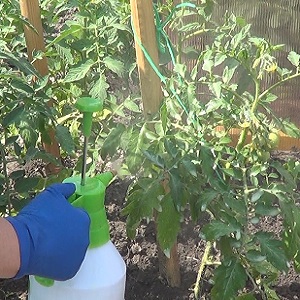 Yeast... Organic dressing increases the plant's immunity and fruiting, helps to endure the heat. To prepare the solution, use dry powder or yeast in granules. Place 100 g of the substance in a bucket of warm water. Once a week, a liter of solution is poured under each plant.
Yeast... Organic dressing increases the plant's immunity and fruiting, helps to endure the heat. To prepare the solution, use dry powder or yeast in granules. Place 100 g of the substance in a bucket of warm water. Once a week, a liter of solution is poured under each plant.- Herbal infusions... The advantage of herbal infusions is that tomatoes receive nitrogen in an easily digestible form. Any plastic container is suitable for preparing the infusion. 2/3 the container is filled with grass. It should not contain seeds. Then water is poured. It should not reach 5-10 cm from the edge. Then the container is covered with foil and left for 2 weeks. The roots are watered with a solution diluted with water in a ratio of 1:10.
- Compost... One of the best top dressing for tomatoes is compost. It improves soil fertility. But this organic matter must be prepared a year before planting the seedlings in the greenhouse. For compost, freshly cut grass, weeds that do not form seeds, food waste, hay, sawdust, egg shells and much more are suitable. All this is stacked in layers in a special storage for agricultural products. Throughout the year, biochemical reactions take place inside the mixture, resulting in an organic fertilizer rich in nutrients. Compost is applied immediately before planting seedlings or in autumn.
- Manure... Valuable nutrient for vegetable crops. Manure is brought into the ground in autumn, when the entire crop has already been harvested. Before planting seedlings, the percentage of ammonia in the soil will decrease. 5 kg of manure is applied on 1 m² of land.
- Chicken droppings is also applied to the soil in the fall after harvest.
Mineral mixtures
Mineral mixtures contain substances necessary for plant growth and fruit development. They can contain one component or several.
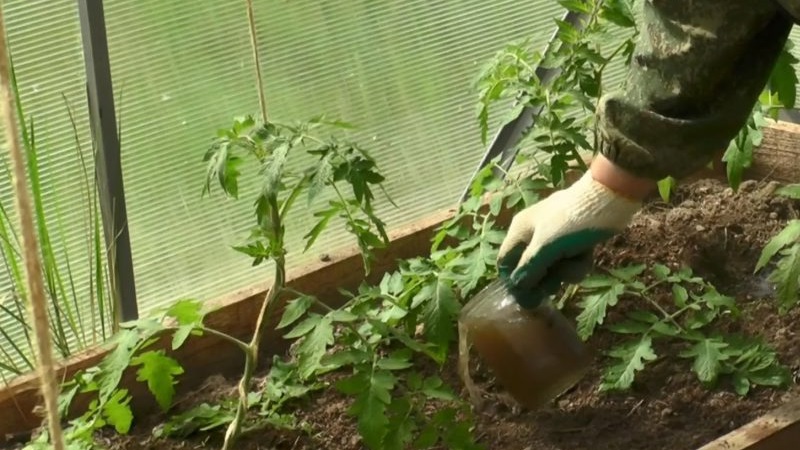
The best mixtures and rules for their introduction
Most effective complex mineral fertilizing for plants:
- Nitroammofoska... The mineral fertilizer is rich in phosphorus, nitrogen and potassium. Directly affects yield indicators. In a container, 50 g of nitrophoska in 10 liters of water are dissolved until the granules disappear completely. The solution is poured into each well before planting. 1 liter of top dressing is used for one tomato bush.
- Calcium nitrate... The substance is rich in calcium and nitrogen, promotes intensive plant growth and fruit development. Dissolve 20 g of fertilizer in a bucket of water.For the first time, root feeding is done 7 days after planting in open ground, then once a week until flowers appear.
- Ammophos... Contains a lot of phosphorus. Fertilizer stimulates fruiting and root development. Top dressing can be applied dry (in the ground at a distance of 10 cm from the arch) or watered with a solution under the root.
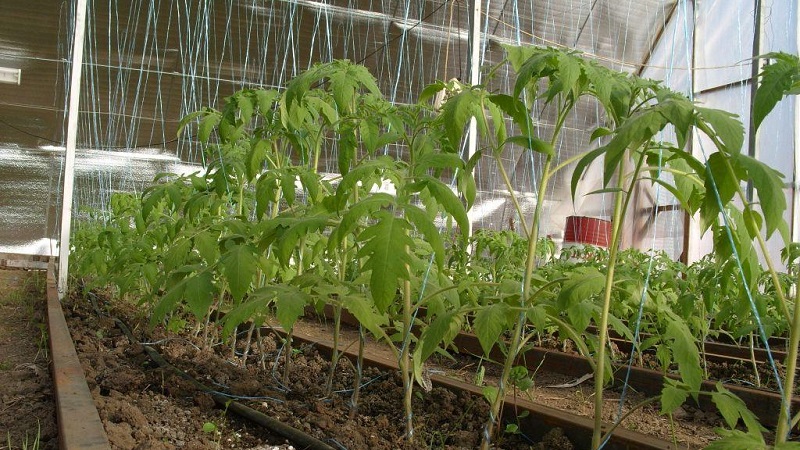
How to determine which minerals are missing
In order not to use fertilizers unnecessary to tomatoes, not to waste energy, time and money on preparing solutions, you need to learn to determine the needs of plants:
- phosphorus - plants are difficult to tolerate cold, resistance to diseases and pests is sharply reduced;
- potassium - a lack of potassium has a bad effect on the taste of fruits and the condition of the root system;
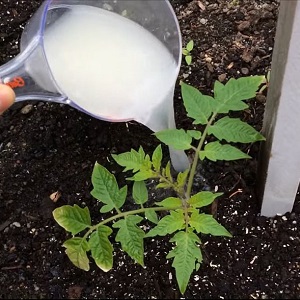 nitrogen - if the plant lacks nitrogen, the leaves may turn yellow, the development of the plant's vegetative system will stop, the roots will weaken, the yield will decrease;
nitrogen - if the plant lacks nitrogen, the leaves may turn yellow, the development of the plant's vegetative system will stop, the roots will weaken, the yield will decrease;- calcium - leaves curl;
- magnesium and zinc - the leaves become domed, small, may be covered with yellow dots;
- sulfur - the plants begin to wither, the leaves turn yellow on the upper side of the bush;
- boron - tomatoes lose the ability to set fruit;
- copper - the leaves become lethargic, become white, new leaves grow with a bluish tint;
- manganese - foliage becomes variegated, dark veins;
- molybdenum - the leaves become spotty, then the edges of the leaf curl inward or die off;
- iodine - plants suffer from fungal infections (brown spot, late blight, root rot).
Read also:
Why spray tomatoes with serum with iodine
Why tomatoes do not grow in a greenhouse and what to do about it
Tips and tricks from experienced farmers
In order for tomatoes to grow well and bear fruit, follow advice from experienced farmers:
- You should not plant tomatoes in soil that is too fertilized with organic matter.
- The first feeding of tomatoes planted in the ground is carried out in early June.
- It is not recommended to use manure for fertilizing tomatoes more than 2 times per season.
- The best fertilizing for seedlings is any liquid organic fertilizer (example: vermicompost). It is bred in accordance with the instructions, a little ash is added, and then the plant is watered with a solution.
- If your plants need emergency help, foliar feeding is a way to get nutrients quickly.
Conclusion
When feeding tomatoes, use organic and mineral fertilizers, but do not unreasonably increase the amount of fertilizing - they depend on the growing season and the needs of the plant.
Observe the condition of the bushes during the growth of the vegetable crop. Poor leaf and root condition can indicate which substance is missing. Nitrogen, phosphorus and potassium are three essential elements that a plant needs at every stage of its development.